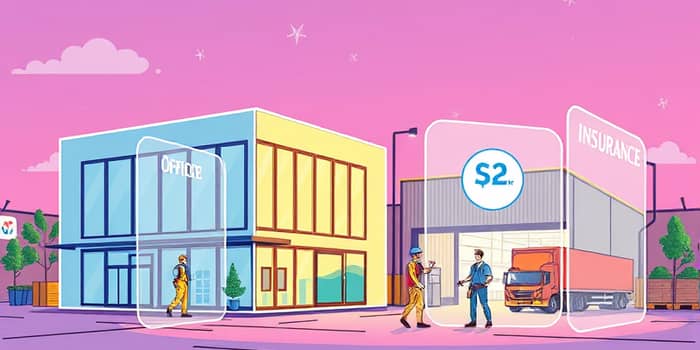
Every day, businesses navigate a landscape of unpredictable challenges—from customer injuries to natural disasters. A comprehensive insurance strategy ensures that a single event does not devastate years of hard work and investment.
In this article, we delve deeply into the core components of business insurance, focusing on liability, property, and workers’ compensation coverages. You will find practical guidance, real-world examples, and best practices to safeguard your enterprise against financial disruption.
At its core, business insurance is a risk management tool designed to transfer the financial consequences of loss from the business owner to an insurer. While premiums represent an ongoing expense, insurance can be the lifeline that keeps operations running after an unexpected incident.
Common insurance types encompass both first-party and third-party coverages. First-party policies protect your own assets and income, while third-party policies address claims brought by customers, vendors, or other external parties.
General liability insurance forms the backbone of most commercial insurance portfolios. It protects businesses from claims involving bodily injuries or property damage arising out of daily operations, customer visits, or completed work.
For instance, if a customer slips and falls in your retail space, general liability can cover medical expenses and legal fees. Average claims in the retail sector can range from $15,000 to over $100,000 depending on injury severity and legal judgments.
Professional liability, often known as Errors & Omissions (E&O) insurance, is essential for service providers. It covers negligence claims, faulty advice, or missed deadlines. Typical premiums start around $500 annually for solo practitioners, increasing with revenue and risk profile.
High-risk industries, such as contracting or healthcare, often supplement primary policies with an umbrella policy to secure an extra layer of protection above standard limits.
Physical assets—buildings, machinery, inventory, and office contents—represent substantial capital investment. Commercial property insurance safeguards these assets against fire, theft, and certain weather events, ensuring you can rebuild after catastrophe.
Policies can be written on a replacement cost basis or actual cash value basis. The former reimburses the full cost to replace damaged items, while the latter accounts for depreciation, potentially reducing settlement amounts.
Optional enhancements like equipment breakdown and debris removal can expedite recovery. Business interruption insurance, a critical rider, compensates for lost income and ongoing expenses if operations are suspended due to a covered peril.
Workers’ compensation insurance fulfills the dual purpose of providing prompt benefits to injured workers while shielding employers from costly lawsuits. Coverage extends to workplace injuries, occupational illnesses, and work-related stress claims.
In most states, businesses must carry workers’ compensation once they reach a specific employee threshold—five employees in Tennessee or two in Virginia. Premiums are calculated based on payroll, job classifications, and historical claim data.
The insurance pays for medical expenses, lost wages, and disability benefits, and may include rehabilitation and death benefits. Companies with safe work environments and robust training programs often earn lower experience modification rates, reducing overall costs.
Independent contractors do not always count toward mandatory coverage thresholds, but misclassification can trigger fines and retroactive premiums. Always verify state guidelines and maintain meticulous records.
Securing individual policies can lead to gaps in coverage and higher administrative overhead. A Business Owners Policy (BOP) combines general liability, property, and business interruption into a single, streamlined package, often delivering bundle policies for greater savings versus separate purchases.
Other bundling options include professional liability with cyber insurance, or umbrella coverage atop existing primary policies. Bundling simplifies billing, ensures cohesive coverage, and may qualify for multi-policy discounts.
Premiums fluctuate based on:
Compliance with insurance mandates is non-negotiable. States enforce workers’ compensation laws with heavy penalties for non-compliance, including fines, license revocations, and stop-work orders.
Professional service firms may face additional bonding requirements or E&O mandates to preserve licensure in fields such as accounting, architecture, or healthcare.
Contractor and trade businesses should note that subcontractor injuries can count toward employee thresholds in many jurisdictions. It is critical to acknowledge that state-specific legal requirements need local compliance to avoid penalties and coverage gaps.
Insurance should evolve alongside your business. Initial policies may suffice for a startup, but growth, acquisitions, or new product lines often introduce fresh exposures.
Maintaining open communication with insurers can facilitate streamlined claims handling and prevent unwelcome surprises during renewals. Documenting incident histories and safety measures can support lower premium negotiations.
Insurance is more than a box to check; it’s a strategic asset that enables businesses to weather disruptions gracefully. From third-party liability claims to the collapse of physical infrastructure, having the right policies in place is crucial for long-term success.
By understanding the nuances of liability, property, and workers’ compensation insurance, and by incorporating best practices into your risk management plan, you can secure a robust defense against the unforeseen. Invest the time to tailor coverage, engage expert advice, and review your policies regularly to ensure your business remains resilient in an ever-changing world.
References













